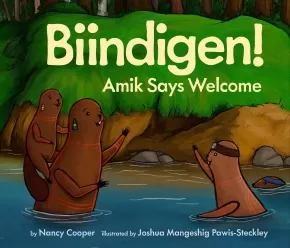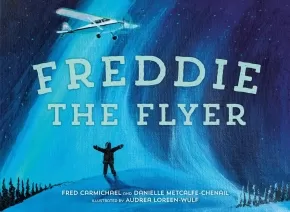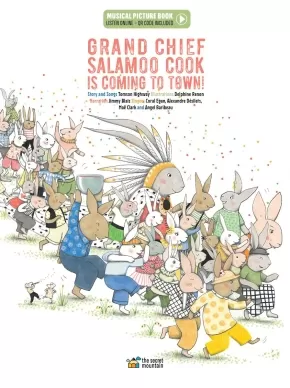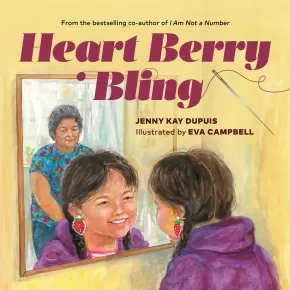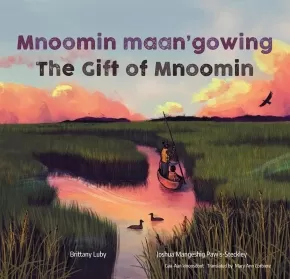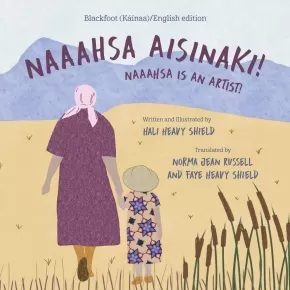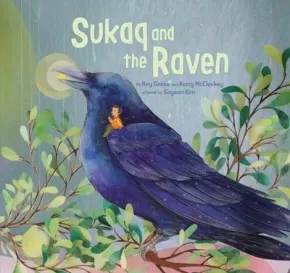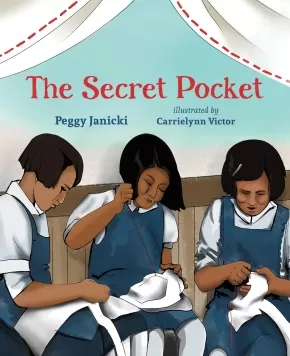
Canadian Indigenous Resource Lists
31
-
45
of
422 Results;
Sort By
Go To
of 29
What If Bedtime Didn't Exist?
$23.99
Artists:
Format:
Hardcover
Text Content Territories:
Indigenous;
ISBN / Barcode: 9781773218687
Synopsis:
Synopsis:
A whimsical and lyrical celebration of imagination and exploration if we simply asked, “What if . . .”
Follow two siblings through their day as they let their imaginations run wild in this joyful story about all the possibilities a simple “what if” can conjure up: What if the monsters in your closet wanted to be your friend? What if all of the dinosaurs were shrunk to be teeny-tiny when the comet hit the earth? And what if bedtime didn’t exist and we could imagine anything we wanted?
What If Bedtime Didn’t Exist? places an Urban Indigenous family at the heart of a fun and fantastical celebration of daydreaming, adventure, and play while living in the city. The tenderness and care in this intergenerational home is seen through relationships with all members in the family.
Mathias Ball’s vibrant illustrations bring each page of acclaimed author Francine Cunningham’s debut picture book to life. What If Bedtime Didn’t Exist? opens up new spaces for creativity and endless possibilities into our everyday world.
Reviews
“A tenderly written, beautifully illustrated story that taps into our creative selves. I can already hear the oohs and awes and giggles, and see little fingers circling around the drawings discovering each “what if” and imagining the imaginings. A wonderful story that’s going to kick off so many conversations between readers about all of the “what ifs!”. So much fun!” — Julie Flett, author of We All Play and Birdsong
“What if the imagination of kids created the world? Then every day would be filled with the rollicking, bright and sparkling, fantastical, astronomical adventures Francine Cunningham and Mathias Ball give us here. Sign me up!” — Caroline Adderson, author of more than twenty books for children including It Happened on Sweet Street and Norman, Speak!
“What if Bedtime Didn’t Exist? is a day dream that sings and celebrates the innocence of imagination. Every page is pure cozy magic! I want to live in this book! I love it!” — Richard Van Camp, author of What’s the Most Beautiful Thing You Know About Horses?
“Francine Cunningham has gifted us a story for readers in search of adventure in the everyday. What if Bedtime Didn’t Exist showcases Cunningham’s writing as expansive as riding with dragons and as intimate as confiding hard feels with ladybugs. For the adventurous and sensitive kid alike, What If Bedtime Didn’t Exist is guided by two Indigenous siblings with boundless curiosity, who remind us that the true source of our magic is embedded in our own imaginations.” — Whitney French, editor of Black Writers Matter
Educator Information
Recommended for ages 4 to 7.
Recommended in the Indigenous Books for Schools catalogue as a valuable resource for English Language Arts for k to 3.
Themes: Childhood, Family.
Additional Information
36 pages | 10.00" x 8.50" | Hardcover
Biindigen! Amik Says Welcome
$21.95
Format:
Hardcover
Text Content Territories:
Indigenous Canadian; First Nations; Anishinaabeg; Algonquin; Cree (Nehiyawak); Haudenosaunee (Iroquois); Kanyen'keha:ka (Mohawk); Mi'kmaq; Salish; Coast Salish; Inuit;
ISBN / Barcode: 9781771475150
Synopsis:
Synopsis:
Busy beavers have a family reunion in this story that celebrates Indigenous perspectives.
It’s a special day for Amik the beaver and her little sister, Nishiime. Their cousins are coming to visit! Amik is excited, but Nishiime feels nervous about meeting new people, and when the cousins finally arrive, Nishiime disappears.
Lively, immersive illustrations show Amik and her cousins as they search the woods for Nishiime. Each creature they encounter, introduced to readers using their Anishinaabe names, reveals how beavers help the forest community. A fish thanks them for digging canals in the mud that they swim through. A deer thanks the beavers for cutting down trees so they can reach the tastiest leaves. None of the creatures have seen Nishiime, but keen-eyed kids will have spotted her hiding in the background throughout the story.
Eventually, Nishiime returns to the group, having overcome her shyness by learning an important lesson: despite being from different places, the beavers are all united by the ways they support the forest ecosystem. With the perfect blend of fact and fun, this salute to the industrious beaver is also an energetic celebration of Indigenous perspectives, languages, and diversity.
Educator Information
Recommended for ages 3 to 7.
Includes some Anishinaabe words. A glossary is found at the back of the book.
Each beaver in the story comes from a different Nation, and their names mean "beaver" in their own language.
Curriculum Connections
Language Arts: Reading
Science: Needs and Characteristics of Living Things; Habitats
Social Studies: Indigenous Peoples
Additional Information
32 pages | 10.50" x 9.00" | Hardcover
Freddie the Flyer
$23.99
Artists:
Format:
Hardcover
Text Content Territories:
Indigenous Canadian; First Nations; Dene; Dinjii Zhuh (Gwich'in);
ISBN / Barcode: 9781774880807
Synopsis:
Synopsis:
A gorgeous picture book that pays homage to aviator Freddie Carmichael — the first Indigenous commercial pilot in the Arctic —with each month of the year highlighting moments from his life, the beauty of the North and the power of dreams.
When Freddie was young, he saw a plane up close for the first time when it dropped off supplies at his family’s remote bush camp. He was instantly hooked.
Freddie has flown for nearly seventy years, doing everything from supply runs to search and rescue to transporting dog teams to far-flung areas.
This book celebrates Freddie’s early dreams of flying and his later achievements. Readers move with Freddie through the year, hearing about his journey as a pilot and leader, while learning the names of the months in Gwich’in and Inuvialuktun at the same time. Art from Inuvialuit painter Audrea Loreen-Wulf perfectly captures the incredible Western Arctic as well as Freddie’s love for aviation.
Reviews
"The story of an Indigenous boy who dreamed of taking to the sky unfolds across the year in this picture-book biography that draws on Gwich’in language, the power of an unshakable passion, and, as rendered in the gorgeous painted illustrations, the beauty of nature." —Booklist
Educator Information
Recommended for ages 3 to 7.
Additional Information
32 pages | 11.31" x 8.25" | Hardcover
Grand Chief Salamoo Cook is Coming to Town!
$19.95
Artists:
Format:
Hardcover
Text Content Territories:
Indigenous Canadian; First Nations; Cree (Nehiyawak);
ISBN / Barcode: 9782898360428
Synopsis:
Synopsis:
Once upon a magical time, a young rabbit named Weeskits hurried home to Kisoos—a town known as the Earth’s belly button—to deliver some thrilling news. Salamoo Cook, the Grand Chief of all rabbits in the world, was on his way to announce a mysterious contest. The prize? A year’s supply of all-healing waaskeechoos juice, fresh from spruce cones that have just fallen. Would Weeskits be able to help his brother Keegach win the juice to rid his wife of the dreadful manchoos?
Grand Chief Salamoo Cook is Coming to Town! is a laugh-out-loud riot of a tale in English, interspersed with nine jazzy songs performed in Cree.
This musical picture book includes a QR code to access the narrated story and songs online and a glossary of Cree words used throughout the tale.
Educator Information
Recommended for grades 2 and 3.
This musical picture book includes a QR code to access the narrated story and songs online and a glossary of Cree words used throughout the tale.
Themes / Subjects: Music, Friendship, Nature, Cree.
This book is available in French: Le grand chef Salamoo Cook arrive en ville !
Additional Information
48 pages | 8.10" x 10.70" | Hardcover
Heart Berry Bling
$24.95
Artists:
Format:
Hardcover
Text Content Territories:
Indigenous Canadian; First Nations; Anishinaabeg;
ISBN / Barcode: 9781774920558
Synopsis:
Synopsis:
On a visit to her granny, Maggie is excited to begin her first-ever beading project: a pair of strawberry earrings. However, beading is much harder than she expected! As they work side by side, Granny shares how beading helped her persevere and stay connected to her Anishinaabe culture when she lost her Indian status, forcing her out of her home community—all because she married someone without status, something the men of her community could do freely.
As she learns about patience and perseverance from her granny’s teachings, Maggie discovers that beading is a journey, and like every journey, it’s easier with a loved one at her side.
In this beautifully illustrated book, children learn about the tradition of Anishinaabe beadwork, strawberry teachings, and gender discrimination in the Indian Act.
Reviews
"Social justice messages lie at the heart of many children’s and YA books with Indigenous authorship. The picture book Heart Berry Bling, written by Jenny Kay Dupuis, a member of the Nipissing First Nation, and illustrated by Ghana-born artist Eva Campbell, shares the tradition of Anishinaabe beadwork and highlights the experiences of women, including the author’s grandmother, who lost their First Nations status due to Canada’s Indian Act."— Publishers Weekly
"A delightful story."— Anishnabek News
"Heart Berry Bling is a soulful children’s story that reminds readers of not only the importance of family and culture, but also the generational harm caused by laws against Indigenous Peoples. In this tale of a young Anishinaabe girl who finds out how her own family was negatively impacted by the Indian Act, Jenny Kay Dupuis has created an important text for anyone learning of the erased ancestral stories from and about Indigenous Peoples." — John P. Broome, Purdue University
Educator Information
Recommended for ages 6 to 8.
Additional Information
48 pages | 9.00" x 9.00" | Hardcover
I Am A Rock
$22.95
Artists:
Format:
Hardcover
Text Content Territories:
Indigenous Canadian; Inuit;
Grade Levels: Preschool; Kindergarten;
ISBN / Barcode: 9781772274752
Synopsis:
Synopsis:
Pauloosie loves his pet rock, Miki Rock. Pauloosie’s Anaana, his mother, tells him a bedtime story about what Miki Rock sees, hears, and feels in his Arctic home. As part of the land, Miki Rock sees char and beluga, listens to chirps and howls, and feels the snow and sun.
Through lyrical text and ethereal landscape illustrations by Pelin Turgut, readers are taken on an Arctic journey from the point of view of a most unlikely object—a child’s pet rock.
Educator Information
Recommended for ages 3 to 5.
Recommended in the Indigenous Books for Schools catalogue as a valuable resource for English Language Arts and Science for K to 2.
Themes: Animals, Land, Respect, Arctic, Connection to Nature
Additional Information
28 pages | 9.00" x 9.50" | Hardcover
Mnoomin maan'gowing / The Gift of Mnoomin
$21.99
Format:
Hardcover
Text Content Territories:
Indigenous Canadian; First Nations; Anishinaabeg; Ojibway;
ISBN / Barcode: 9781773068466
Synopsis:
Synopsis:
In this bilingual book, an Anishinaabe child explores the story of a precious mnoomin seed and the circle of life mnoomin sustains.
Written in Anishinaabemowin and English, the story opens at harvest time. A child holds a mnoomin seed and imagines all the life that made a single seed possible-Mayfly, Pike, Muskrat, Eagle and Moose, all had a part to play in bringing the seed into being. What will happen if the seed sprouts? Underwater leaves will shelter young fish, shoots will protect ducklings, stalks will feed larvae, in turn providing food for bats...until finally mnoomin will be ready to harvest again.
We follow the child and family through a harvest day as they make offerings of tobacco, then gently knock ripe seeds into their canoe. On shore, they prepare the seeds, cook up a feast, and gratefully plant some seeds they'd set aside.
This beautifully written and illustrated story reveals the cultural and ecological importance of mnoomin. As the author's note explains, many Anishinaabeg agree that "wild rice" is an inaccurate term for this plant relation, since part of the harvest is sown every year to help sustain human and non-human beings. Includes a translator's note.
Educator Information
Recommended for ages 3 to 6.
Thi book is written in Anishinaabemowin and English.
Key Text Features:
- explanation
- illustrations
- informational note
- translations
- translator's note
Correlates to the Common Core State Standards in English Language Arts:
CCSS.ELA-LITERACY.RL.1.2
Retell stories, including key details, and demonstrate understanding of their central message or lesson.
Translated by Mary Ann Corbiere, who grew up in Wiikwemkoong Unceded Territory on Manitoulin Island speaking Nishnaabemwin. She taught her language at the University of Sudbury for many years, obtained a doctorate and continues to work on instructional resources for adult learners. She now lives in Lively, Ontario.
This book is available in Anishinaabemowin and French: Précieux mnoomin
Additional Information
36 pages | 8.75" x 8.50" | Hardcover
Naaahsa Aisinaki! / Naaahsa is an Artist!
$21.95
Format:
Hardcover
Text Content Territories:
Indigenous Canadian; First Nations; Blackfoot Confederacy (Siksikaitsitapi); Kainai (Blood);
ISBN / Barcode: 9781772603477
Synopsis:
Synopsis:
Naaahsa says art is a language everyone understands. Sometimes we make art together. We draw, we bead, we sing. Sometimes Naaahsa tells stories in Blackfoot. I even get to go with her to see her art show at the National Gallery. Naaahsa is famous for her art, but I love her hugs best!
Naaahsa is an Artist! is a celebration of art, artists, and Indigenous women artists in particular. Each page comes to life with bold patterns, shapes, and Naaahsa's encouraging words that may inspire young readers to want to make art themselves.
Educator Information
Recommended for ages 6 to 8.
Dual-language edition in English and Blackfoot: Kainai Nation
Blackfoot translation by Norma Jean Russell and Faye Heavy Shield.
This book is available in English: Naaahsa is an Artist!
Additional Information
24 pages | 8.50" x 8.50" | Hardcover
Nutshimit: In the Woods
$22.99
Artists:
Format:
Hardcover
Text Content Territories:
Indigenous Canadian; First Nations; Innu (Montagnais-Naskapi); Ekuanitshit; Inuit; Métis;
ISBN / Barcode: 9781039701809
Synopsis:
Synopsis:
In this immersive first-person account, Innu author Melissa Mollen Dupuis teams up with award-winning author and illustrator Elise Gravel to take readers on a journey through Innu culture, from creation legends to life today.
The Innu word Nutshimit signifies the physical and social space to practice traditional activities and language. Join author Melissa Mollen Dupuis on a guided walk deep through the forest to learn some of the rich culture of the Innu people.
Readers will discover the importance of natural world and learn a few Innu words along the way. Thoughtfully brought to life by Elise Gravel’s signature comic style illustrations, Melissa’s colloquial narrative and anecdotes detailing her lived experiences offer a deeply personal look at Innu life.
Educator Information
Recommended for ages 6 to 8.
Children learn Innu nature vocabulary through anecdotes from author’s lived experiences.
Populated with Elise Gravel’s hilarious characters and plenty of fun details.
This book is available in French: Nutshimit: Un bain de forêt
Find an activity book for this title here: Nutshimit: Activity Book
Additional Information
88 pages | 8.00" x 11.00" | Hardcover
Powwow Dancing With Family (PB)
 $16.95
$16.95

Artists:
Format:
Paperback
Text Content Territories:
Indigenous Canadian; First Nations; Salish; Interior Salish; Secwepemc (Shuswap);
ISBN / Barcode: 9781771746281
Synopsis:
Synopsis:
Drumming, singing, and dancing are all part of being at a Powwow. Perry and his family travel all over North America to participate in these family and community gatherings. Join Perry’s two boys as they share their treasured memories of being at Powwows with their family and learning how to dance.
Reviews
“Lavishly illustrated with photographs, vivid sketches, and ledger art, Powwow Dancing With Family provides a detailed description of each stage of the Powwow, historical and contemporary aspects of the Powwow, and pays homage to Indigenous culture and customs. This informative resource will support studies of Indigenous culture, history, traditions, community, art, and family lifestyle.” – ERAC Review, May 2019
Educator Information
Includes three pages of educational material on Powwows with information found under these headings:
- What is a Powwow?
- Powwow Regalia
- Powwow Dances
About Perry Smith's Ledger Art:
Ledger Art is an art form that was developed in the mid 1800s to early 1900s by the Plains First Nations during a time when reserves were being established across North America. The ledger books were acquired in trade, war, or raids. New art supplies were also introduced: coloured pencils, crayons, and occasionally water paints. The new supplies were favoured by artists over the traditional bone and stick brushes. Many of the artworks within these ledger books display a traditional way of life, before assimilation. Today these artworks are greatly valued for the historical perspective that they offer.
Additional Information
32 pages | 8" x 8" | ISBN: 9781771746281 | Paperback
Sukaq and the Raven (PB)
$13.95
Artists:
Format:
Paperback
Text Content Territories:
Indigenous Canadian; Inuit;
ISBN / Barcode: 9781772274349
Synopsis:
Synopsis:
Sukaq loves to drift off to sleep listening to his mother tell him stories. His favourite story is the tale of how a raven created the world. But this time, as his mother begins to tell the story and his eyelids become heavy, he is suddenly whisked away on the wings of the raven to ride along as the entire world is formed! This traditional legend from Inuit storyteller Roy Goose is brought to life through co-author Kerry McCluskey's jubilant retelling.
Additional Information
36 pages | 9.25" x 9.25" | Paperback
The Origin of Day and Night (PB)
$13.95
Artists:
Format:
Paperback
Text Content Territories:
Indigenous Canadian; Inuit;
ISBN / Barcode: 9781772274691
Synopsis:
Synopsis:
In very early times, there was no night or day and words spoken by chance could become real. When a hare and a fox meet and express their longing for light and darkness, their words are too powerful to be denied. Passed orally from storyteller to storyteller for hundreds of years, this beautifully illustrated story weaves together elements of an origin story and a traditional animal tale, giving young readers a window into Inuit mythology.
Educator Information
Recommended in a Canadian Indigenous Books for Schools resource list as being useful for grades 2-5 in these subject areas: English Language Arts, Social Studies.
Useful as a read-aloud, independent read, or information resource for students.
Additional Information
32 pages | 9.00" x 8.00" | Paperback
The Secret Pocket
$21.95
Artists:
Format:
Hardcover
Text Content Territories:
Indigenous Canadian; First Nations; Dene; Dakelh (Carrier);
ISBN / Barcode: 9781459833722
Synopsis:
Synopsis:
The true story of how Indigenous girls at a Canadian residential school sewed secret pockets into their dresses to hide food and survive
Mary was four years old when she was first taken away to the Lejac Indian Residential School. It was far away from her home and family. Always hungry and cold, there was little comfort for young Mary. Speaking Dakelh was forbidden and the nuns and priest were always watching, ready to punish. Mary and the other girls had a genius idea: drawing on the knowledge from their mothers, aunts and grandmothers who were all master sewers, the girls would sew hidden pockets in their clothes to hide food. They secretly gathered materials and sewed at nighttime, then used their pockets to hide apples, carrots and pieces of bread to share with the younger girls.
Based on the author's mother's experience at residential school, The Secret Pocket is a story of survival and resilience in the face of genocide and cruelty. But it's also a celebration of quiet resistance to the injustice of residential schools and how the sewing skills passed down through generations of Indigenous women gave these girls a future, stitch by stitch.
Awards
- 2023 Sunshine Coast Writers and Editors Society (SCWES) Book Awards for BC Authors joint winner
- 2024 Forest of Reading Silver Birch Express Award
Reviews
“In bringing her mother’s story to the world, Peggy Janicki has ignited a powerful fire for intergenerational healing. A vivid illustration of how Traditional Knowledge helped the children at residential schools be heroes for themselves and each other. Not only has Janicki meticulously documented everyday life as experienced by the students of the Lejac residential school but she has also highlighted their ingenious and courageous efforts to survive. Strengths-based, age-appropriate and vividly engaging.”— Christy Jordan-Fenton, award-winning author of Fatty Legs
“Beautifully illustrated and powerfully narrated, The Secret Pocket amplifies the voices and experiences of Indian Residential School Survivors. In doing so, Peggy Janicki and Carrielynn Victor make an important contribution to the work of putting truth before reconciliation.”— Sean Carleton, historian and author of Lessons in Legitimacy: Colonialism, Capitalism, and the Rise of State Schooling in British Columbia
“In this important story of courage and resistance, educator Peggy Janicki shares the story of her mother and other Survivors who sewed secret pockets into their dresses to hide food to feed themselves and others at Lejac residential school. We need to continue to hear these stories and share them with our children so we can move forward in our collective healing.”— Dr. Sara Florence Davidson, co-author of Potlach as Pedagogy: Learning Through Ceremony
“It is through stories that knowledge, understanding, empathy and the tools for deep and lasting change are passed on. Peggy Janicki has carried her mother’s story for us to hold in our hearts. This truth-telling and history-sharing will touch readers of all ages as they allow themselves to feel the weight of this powerful book.”— Amber Price, MGC, owner of The Book Man
Educator Information
Recommended for ages 6 to 8.
This book is available in French: La poche secrète.
Additional Information
32 pages | 8.75" x 10.75" | Hardcover
The Song That Called Them Home
$24.99
Format:
Hardcover
Text Content Territories:
Indigenous Canadian; First Nations; Cree (Nehiyawak);
ISBN / Barcode: 9780735266704
Synopsis:
Synopsis:
From the award-winning author of On the Trapline comes a cinematic fantasy-adventure story inspired by Indigenous legends.
One summer day, Lauren and her little brother, James, go on a trip to the land with their Moshom (grandfather). After they've arrived, the children decide to fish for dinner while Moshom naps. They are in their canoe in the middle of the lake when the water around them begins to swirl and crash. They are thrown overboard and when Lauren surfaces she sees her brother being pulled away by the Memekwesewak — creatures who live in and around water and like to interfere with humans. Lauren must follow the Memekwesewak through a portal and along a watery path to find and bring back James. But when she finally comes upon her brother, she too feels the lure of the Memekwesewak’s song. Something even stronger must pull them back home.
Educator Information
Recommended for ages 4 to 8.
This book is available in French: Le chant vers la maison
Additional Information
52 pages | 9.00" x 10.25" | Hardcover
The Spirit Trackers (PB)
$14.95
Artists:
Format:
Paperback
Text Content Territories:
Indigenous Canadian; First Nations; Anishinaabeg;
ISBN / Barcode: 9781771770187
Synopsis:
Synopsis:
Will and Tom speak in a whisper.
"Uncle, tell us the story of the Windigo."
The boys look behind them for something they can't see.
When Uncle shares the story of the Windigo, the cousins get more than they expect. That night something strange scratches at the frost on their bedroom window. In the morning they find huge tracks in the snow. The Wandering Night Spirit of Winter!
Tom and Will know what good Trackers would do, so they follow the trail deep into the forest. Then a strange cry slices the air.
"Remember," Will whispers as they move forward. "Don't look into its eyes."
Can you be a tracker too? Find the tracks hidden in the pictures.
Reviews
"Gorgeous illustrations and suspenseful writing fully engross the reader and have my kids sitting on the edge of their seats every time. This emotional engagement makes it a perfect read for discussing the concept of bravery, while the story's details provide wonderful cultural education. And as a fun bonus, the endpapers show different animal tracks that you can spot throughout the book - just like good Trackers!"— Read. Learn. Repeat. Blog
"Richly illustrated in mixed media, Waboose weaves a story of respect for nature and family. The boy's insistence of their bravery is countered by their natural fear of the unknown — and the stories they have heard. A great read for a stormy winter night. Beware of the Windigo!"— kissthebookjr.blogspot.com
"Anishinaabe Waboose's prose seamlessly threads her people's legends with her story of a modern First Nations family that is keeping its traditions alive. Award-winning illustrator Thisdale's expressive and detailed illustrations add depth to Waboose's engaging text. His mixed-media paintings successfully blend the traditional and the modern, the comfortably familiar and the uncanny, to support the story's themes. An intergenerational tale that celebrates both a specific tradition and the universal curiosity of children."— Kirkus Starred Review
Educator Information
Recommended in the Canadian Indigenous Books for Schools 2019-2020 resource list as being useful for grades K-4 for English Language Arts.
Young readers will be able to improve their tracking skills as they find clues hidden in the illustrations along with Will and Tom.
Additional Information
32 pages | 8.50" x 11.00" | Paperback
Sort By
Go To
of 29




